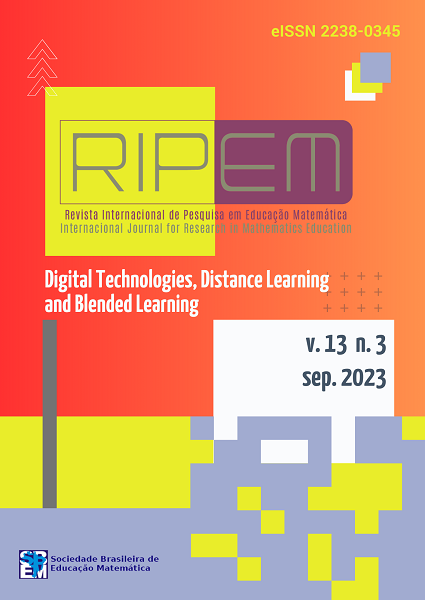Multimodality and the expression of mathematical ideas through videos by Mathematics undergraduates
DOI:
https://doi.org/10.37001/ripem.v13i3.3573Keywords:
Video Production, Semantic Expansion, Analytical Geometry, Distance EducationAbstract
The research reported in this article sought to understand how Mathematics undergraduates in Distance Education combine semiotic resources when using videos to express mathematical ideas. Adopting the qualitative methodology, the research was developed with students of the Analytical Geometry discipline and the participant observation in forums of the virtual learning environment was used in the monitoring of the video productions by the participants. Functional Systemic — Multimodal Discourse Analysis supported the analysis of the strategies used in the combinations of semiotic resources in the produced videos. In this article, the analysis of one of the videos produced in the research is discussed. As a result, it was found that the multimodal nature of the video encourages the use of contextualization in the construction of digital mathematical discourse. However, the concepts are formalized from a recontextualization referring to the classroom, which shows the influence of the experience in this environment in the construction of the mathematical discourse shared in the online environment in the context of this research.
Downloads
References
Alibali, M. W.; Nathan, M. J.; Church, R. B.; Wolfgram, M. S.; Kim, S. & Knuth, E. (2013). Teachers’ gestures and speech in Mathematics lessons: forging commom ground by resolving trouble spots. ZDM Mathematics Education, 45, 425-440.
Andrade, J. P & Sartori, J. (2018). O professor autor e experiências significativas na educação do século XXI: estratégias ativas baseadas na metodologia de contextualização da aprendizagem. In: L. Bacich & J. Moran (Org.). Metodologias ativas para uma educação inovadora: uma abordagem teórico-prática. (pp. 175-198). Porto Alegre, RS: Penso Editora.
Borba, M. C.; O’Halloran, K. L. & Neves, L. X. (2021). Multimodality, Systemic Functional-Multimodal Discourse Analysis and Production of Videos in Mathematics Education. In: M. Danesi (Ed.). Handbook of Cognitive Mathematics. (pp. 1-30). Switzerland: Springer Nature.
Borba, M. C.; Scucuglia, R. & Gadanidis, G. (2018). Fases das tecnologias digitais em Educação Matemática: sala de aula e internet em movimento. 2.ed. Belo Horizonte, MG: Autêntica.
Castells, M. (1999). A sociedade em rede. São Paulo, SP: Paz e Terra.
Creswell, J. W. (2014). Investigação qualitativa e projeto de pesquisa: escolhendo entre cinco abordagens. (3a ed.). Porto Alegre, RS: Penso.
Engelbrecht, J.; Llinares, S. & Borba, M. C. (2020). Transformation of the mathematics classroom with the internet. ZDM Mathematics Education, 52, 825-841.
Ferrés, J. (1995). VÃdeo e educação. (2a ed.) Porto Alegre, RS: Artes Médicas.
Friedlander, A. & Tabach, M. (2001). Promoting multiple representations in algebra. In: A. A. Cuoco & F. R. Curcio (Org.). The roles of representation in schools Mathematics (pp. 173-185). Yearbook 2001. Reston, WV: NCTM.
G., M. S.; Mill, D. & Nagem, R. L. (2013). Sobre metáforas e animação cinematográfica em processos educacionais: riquezas e cuidados pedagógicos no uso do vÃdeo na educação. In: Mill, D. (Org). Escritos sobre Educação: desafios e possibilidades para ensinar e aprender com as tecnologias emergentes (pp. 295-323). São Paulo, SP: Paulus.
Jewitt, C.; Bezemer, J. & O’Halloran, K. L. (2016). Introducing Multimodality. New York, WA: Routledge.
Lemke, J. L. (2010). Letramento metamidiático: transformando significados e mÃdias. Trabalhos em LinguÃstica Aplicada, 49(2), 455-479.
Lévy, P. (1993). As tecnologias da inteligência: o futuro do pensamento na era da informática. Rio de Janeiro, RJ: Editora 34.
Marshall, M. N. (1996). Sampling for qualitative research. Family Practice, 13(6), 522-525.
McNeill, D. (1992). Hand and mind: what gestures reveal about thought. Chicago, IL: University of Chicago Press.
Moletta, A. (2009). Criação de curta-metragem em vÃdeo digital: uma proposta para produções de baixo custo. (2. ed.). São Paulo, SP: Summus.
Moran, J. M. (2013). Ensino e aprendizagem inovadores com apoio de tecnologias. In: J. M. Moran; M. T. Masetto & M. A. Behrens. Novas tecnologias e mediação pedagógica (21. ed. pp. 11-7221). Campinas, SP: Papirus.
Mortimer, E. F. & Quadros, A. L. (Org.). (2018). Multimodalidade no Ensino Superior. IjuÃ, RS: Editora UnijuÃ.
Neves, L. X. (2020). Intersemioses em vÃdeos produzidos por licenciandos em Matemática da UAB. 2020. 304f. Tese (Doutorado em Educação Matemática). Universidade Estadual Paulista. Rio Claro, SP.
Neves, L. X. & Borba, M. C. (2020). VÃdeos em Educação Matemática sob a luz da Sistêmico Funcional — Análise do Discurso Multimodal. Unión — Revista Iberoamericana de Educación Matematica, 16(59), 159-179.
O’Halloran, K. L. (2018). A multimodal approach for theorising and analysing mathematics textbooks. [Proceedings]. In: Second International Conference on Mathematics Textbook Research and Development. Rio de Janeiro, RJ.
O’Halloran, K. L. (2022). Matter, meaning and semiotics. Visual Communication, 22(1), 174-201.
Powell, A. B. & Silva, W. Q. (2015). O vÃdeo na pesquisa qualitativa em Educação Matemática: investigando pensamentos matemáticos de alunos. In: A. B. Powell(Org.). Métodos de pesquisa em Educação Matemática: usando escrita, vÃdeo e internet. (pp. 15-60). Campinas, SP: Mercado de Letras.
Setton, M. G. (2015). MÃdia e educação. São Paulo, SP: Contexto.
Silva, C. A. & Rosa, M. (2020). Corpo, videogame e constituição de conhecimento matemático: um estudo com Xbox Kinect. Revista Internacional de Pesquisa em Educação Matemática, 10(3), 45-69.
Souto, D. L. P. & Borba, M. C. (2018). Humans–with–internet or internet–with–humans: a role reversal? Revista Internacional de Pesquisa em Educação Matemática, 8(3), 2-23.
Van Leeuwen, T. (2005). Introducing social semiotics. New York, WA: Taylor & Francis E-Library.
Wilkie, K. J. (2016). Student’s use of variables and multiple representations in generalizing functional relationships prior to secundar school. Educational Studies in Mathematics: na International Journal, 93(3), 333-361.
Published
How to Cite
Issue
Section

This work is licensed under a Creative Commons Attribution-NonCommercial-ShareAlike 4.0 International License.








